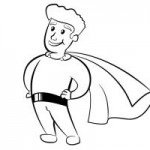By Julie Wright
There is a song by The Smiths where the first line is, “I know I’m unlovable. You don’t have to tell me . . .”
Sometimes we write characters like that, characters who are hard to relate to, hard to like, hard to care about.
Hi. My name is Julie Wright. I write those kinds of characters. The problem is that I never feel like I’m writing those kinds of characters. I happen to love the unlovable. I think sarcasm is funny. I think bitter people sometimes have a right to a good rant. And I think the flaws in each person—the flaws we all have whether we admit it or not—make us wonderfully human.
Jordan has been doing a blog series on creating sympathetic characters. She’s already mentioned the “street rat” and the princess. So you understand already that flawed does not have to equate to evil. But sometimes we writers forget to add the details of our thief sharing his entire meal with a few beggar children. Sometimes we writers know those details, but never get them on the page. For example:
In my novel My Not-So-Fairy-Tale Life, my heroine is horrible. She is sarcastic, bitter, angry and rebellious.  She is angst personified. I love her. But not everybody loves her right at the beginning. She’s one of those characters you have to learn to love. While submitting the book in the beginning, I failed to put in those details about her past and present that made her lovable. I knew those details, but it took me a couple of edits to get them down on the page so the reader knew too. Once those details were there, even if you started out not liking her, you couldn’t help but at least understand her by the end.
She is angst personified. I love her. But not everybody loves her right at the beginning. She’s one of those characters you have to learn to love. While submitting the book in the beginning, I failed to put in those details about her past and present that made her lovable. I knew those details, but it took me a couple of edits to get them down on the page so the reader knew too. Once those details were there, even if you started out not liking her, you couldn’t help but at least understand her by the end.
To start out with someone who is reprehensible and then grow to love them makes for a fun journey for the reader as well as the character. It allows the reader access to understand other people, other motives, other walks of life. It allows the reader to grow and find compassion and comprehension within themselves.
I don’t write the unlovable as a moral object lesson for readers. I think I write them because I was so unlovable for so many years of my youth and I can relate to the unlovable. I am horribly flawed and yet I feel like I have worth—value. If I feel that way, then surely others do as well.
But how do you write snarky, ill-tempered characters and keep readers from throwing your book across the room, or worse from writing you and demanding a refund?
Daphne Atkeson, someone I know from an online writer’s group for YA novels, created what she calls a “cheat sheet” of ways to establish early empathy (not sympathy, if we feel sorry for our characters, we end up making their journey too easy) for a character. She gathered this information from several craft books by Billy Mernitt, Michael Hague, Donald Maass and Orson Scott Card.
Here is her list with her permission:
- undeserved misfortune
- Liked or loved by someone else
- Good at something, has a strength
- Trying to improve or be good
- Wit or boldness
|
- Aware of his flaws
- Has some power
- Has a familiar flaw
- Shows forgiveness
- Self sacrifice
|
In My Not So Fairy Tale Life, I had to incorporate a lot of these things from this list in order to make her relatable to the reader. She was violently abused and neglected as a child so much of her thorny personality was built on purpose as her way of defending herself from getting hurt (undeserved misfortune). Her brother, who is a really nice guy, loves her irrevocably (liked or loved by someone else). She is actually incredibly intelligent (good at something).
When she finds out she’s pregnant and goes to abort the baby, she recognizes she is on a path she can’t continue down so she doesn’t go through with the procedure and works hard to make sure the baby is healthy through the rest of her pregnancy (trying to improve or be good). She VERY sarcastic and has a comeback for just about everything (wit or boldness). She is painfully aware of her flaws. In spite of the abuse she learns to forgive her parents (shows forgiveness). In the end, she gives her baby up for adoption because she knows she isn’t ready or grown up enough to raise a child. And even though it hurts, she gives the baby to a family who is ready for it (self sacrifice).
 Lots of books incorporate the flawed character. Janette Rallison did a smashing job with her book Just One Wish. The character breaks a ton of rules, gets into all kinds of mischief, but she’s doing it all for her little brother who has cancer. You can forgive her the lunacy because you understand the motive.
Lots of books incorporate the flawed character. Janette Rallison did a smashing job with her book Just One Wish. The character breaks a ton of rules, gets into all kinds of mischief, but she’s doing it all for her little brother who has cancer. You can forgive her the lunacy because you understand the motive.
Never forget motivation. Motivation is the driving factor behind everything we do. Along with motivation, a character must have:
- PURPOSE—most important—what he wants, must be specific
- CREDIBILITY—believable
- EMPATHY—not sympathy, don’t feel sorry for him, identify with problem.
- COMPLEXITY—inner conflict, more than one side, surprise us with unseen aspects, contradictions and quirks
To the degree that your character feels passionately invested in his own life, the reader will feel invested, too. We need to be able to root for the character, to care whether or not the character wins the prize. To do so, we need to make sure the character DESERVES to win. In the original movie Willy Wonka & the Chocolate Factory, we realize that even though Charlie stole a little Fizzy-Lifting Drinks, he still deserved to win because he was a good kid.
The reader also needs to know what is at stake. For Janette’s character in Just One Wish, her brother’s life was very literally at stake. In the book The Hunger Games, the main character’s own life was at stake. She needed to get all of her primal needs met (food, shelter, means of defending herself). In the book Sun and Moon, Ice and Snow by Jessica Day George, the life of her beloved is at stake.
Something has to be on the line and it has to be a big something. Your character needs to stretch and grow and they cannot accomplish that if they have silly, paper-thin conflicts to deal with. When you inflict pain and trouble on your hero, you reveal him for who he is. You learn what motivates him, what is important to him. When you inflict pain and trouble on your hero, you discover what exactly it is that makes him the hero.
About the author
Julie Wright is extremely busy as a wife, a mother of three, a rural grocery store owner, and an author of or contributor to six novels and books on writing craft. She blogs at Scattered Jules and Writing on the Wall. Her latest book, Eyes Like Mine, is available for pre-order now.
 What does it mean to have a “sympathetic” character? It means that the reader can relate to him/her. The reader feels the things s/he feels, and the reader understands the difficulties that character is going through. (It doesn’t always mean, however, that the reader likes the character, though that can be helpful.)
What does it mean to have a “sympathetic” character? It means that the reader can relate to him/her. The reader feels the things s/he feels, and the reader understands the difficulties that character is going through. (It doesn’t always mean, however, that the reader likes the character, though that can be helpful.) Kindness to small children and animals isn’t enough—just about anybody but the absolute worst psych- or sociopath is nice to his mother and his babies. Saving orphans from a burning building isn’t going to be enough on its own, either.
Kindness to small children and animals isn’t enough—just about anybody but the absolute worst psych- or sociopath is nice to his mother and his babies. Saving orphans from a burning building isn’t going to be enough on its own, either. Whether we like Scarlett O’Hara or not (and we probably don’t early in the book), we sympathize with her when her impassioned declaration to Ashley (and his wussy rejection of her) turns out to be overheard by, of all people, the arrogant Rhett Butler. The anguish… the embarrassment! We know just how she feels, and somehow we feel even more because our sympathy is unwilling, because we don’t WANT to identify with this snotty little flirt. And we don’t identify with her… that is, until something bad happens to her that we can actually imagine happening to us.
Whether we like Scarlett O’Hara or not (and we probably don’t early in the book), we sympathize with her when her impassioned declaration to Ashley (and his wussy rejection of her) turns out to be overheard by, of all people, the arrogant Rhett Butler. The anguish… the embarrassment! We know just how she feels, and somehow we feel even more because our sympathy is unwilling, because we don’t WANT to identify with this snotty little flirt. And we don’t identify with her… that is, until something bad happens to her that we can actually imagine happening to us.  One of the ways we try to show characters suffering to help build sympathy is through their backstory. We show them growing up, or use flashbacks and memories to show the injustices they’ve suffered. His father was always at work, his mother denied him jelly on his peanut butter sandwiches, his first girlfriend dumped him for a jerk, his first wife cheated on him, his boss doesn’t recognize his work, even his dog doesn’t appreciate him.
One of the ways we try to show characters suffering to help build sympathy is through their backstory. We show them growing up, or use flashbacks and memories to show the injustices they’ve suffered. His father was always at work, his mother denied him jelly on his peanut butter sandwiches, his first girlfriend dumped him for a jerk, his first wife cheated on him, his boss doesn’t recognize his work, even his dog doesn’t appreciate him.  Okay, you guessed it—just like a character who just gets more and more bad stuff piled on, a character who’s easily and confidently stronger than every challenge he faces isn’t really sympathetic.
Okay, you guessed it—just like a character who just gets more and more bad stuff piled on, a character who’s easily and confidently stronger than every challenge he faces isn’t really sympathetic. The next step is getting the reader to support the character’s goals and aspirations. While a character doesn’t have to be admirable, Frey stresses, the easiest way to get readers to support a character’s goal is to make sure their goal is noble.
The next step is getting the reader to support the character’s goals and aspirations. While a character doesn’t have to be admirable, Frey stresses, the easiest way to get readers to support a character’s goal is to make sure their goal is noble.  This doesn’t mean that every sad sack character should be trudging through the pouring rain (to the courthouse to try to win his freedom from a wrongful conviction)—though it might help. It does mean, however, that it helps for the character to take notice of his environs, and for them to mirror (or, possibly, contrast or mock) his internal emotional state.
This doesn’t mean that every sad sack character should be trudging through the pouring rain (to the courthouse to try to win his freedom from a wrongful conviction)—though it might help. It does mean, however, that it helps for the character to take notice of his environs, and for them to mirror (or, possibly, contrast or mock) his internal emotional state. Once upon a time, there was a young man who was a habitual thief. Even though his family was perfectly capable of providing for him, and even though he was perfectly capable of working to support himself, he stole everything he owned and stole from anyone he could. He even subjugated innocent animals to make them steal for him.
Once upon a time, there was a young man who was a habitual thief. Even though his family was perfectly capable of providing for him, and even though he was perfectly capable of working to support himself, he stole everything he owned and stole from anyone he could. He even subjugated innocent animals to make them steal for him. Okay, if you haven’t guessed it by now, I’ll just tell you: our hero is Aladdin from the Disney animated film. And yeah, it’s a kids’ film, so the characterization can be a little . . . well, strong. (How do you convince a five-year-old that the guy stealing on screen is actually the good guy?) But at the same time, it’s done fairly (or at least relatively) believably.
Okay, if you haven’t guessed it by now, I’ll just tell you: our hero is Aladdin from the Disney animated film. And yeah, it’s a kids’ film, so the characterization can be a little . . . well, strong. (How do you convince a five-year-old that the guy stealing on screen is actually the good guy?) But at the same time, it’s done fairly (or at least relatively) believably.

